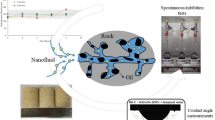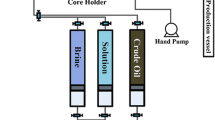Abstract
Nanofluid injection into oil reservoirs is a novel chemical enhanced oil recovery (EOR) method and has been the subject of many researches in recent years. Despite its increasing applications, there is not enough information on the mechanisms and microscopic aspects of nanoparticle performance in EOR processes. Among nanoparticles, Janus nanoparticles (JNPs), which have two distinct hydrophilic and hydrophobic sides, can play an effective role in oil recovery enhancement applications. In the present study, molecular dynamics (MD) simulations were performed to provide a molecular-scale insight into the working mechanisms of silica Janus nanoparticles in oil recovery enhancement by considering the presence of sodium, chlorine, magnesium and sulfate ions. The calcite surface interacts with the mixture of heptane, decane, and toluene as the oil phase. Based on the simulation results, the mechanism of oil detachment from the calcite surface involves several steps. Due to the electrostatic interactions between the nanofluid and the calcite, the formation of a water channel towards the calcite surface begins, and the nanofluid reaches and spreads over the calcite surface, which is influenced by two factors: hydrogen bonds between water and calcite; the presence of ions in the nanofluid, which can increase the hydrophilicity of the calcite surface. Thus, the oil molecules remain as a droplet on the rock surface. Subsequently, the JNPs approach to the oil–water interface near the calcite surface and push the oil droplet upward so that the oil phase completely detaches from the surface. The presence of ionic compounds around the JNPs increases their electrostatic interactions with each other and also increases the probability agglomeration of JNPs, which is a negative factor. On the other hand, they increase the electrostatic interactions of JNPs with calcite, which is a positive factor. Therefore, it is necessary to choose the optimal concentration of the ionic compounds in the injected nanofluid. According to the simulation results, JNPs could increase the viscosity of the water phase by 60% and reduce the surface tension of water–oil by 33%. Under the reservoir temperature and pressure conditions, the diffusion coefficient of 1nm JNPs has increased from 3.33 × 10–10 to 6.67 × 10–10 m2/s. The results of this study may be useful for designing favorable conditions for nanofluid injection in the EOR applications.


















Similar content being viewed by others
Data availability
The data that support the findings of this study are available upon reasonable request.
Abbreviations
- COM:
-
Center of mass
- CSAJN:
-
Composite silica-based amphiphilic Janus nanosheets
- D:
-
Diffusion coefficient
- E:
-
Potential energy
- EOR:
-
Enhanced oil recovery
- EW:
-
Electrolyte water
- g(r):
-
Radial distribution function
- IFT:
-
Interfacial tension
- JNP:
-
Janus nanoparticle
- KB :
-
Boltzmann coefficient
- LAMMPS:
-
Large atomic/molecular massively parallel simulator
- LJ:
-
Lennard–Jones
- Lz :
-
The thickness of the interface
- MD:
-
Molecular dynamics
- MSD:
-
Mean square displacement
- N:
-
Number of atoms
- n(r):
-
Number of atoms in distance r
- NP:
-
Nanoparticle
- NVT:
-
Canonical ensemble
- PPPM:
-
Particle–Particle, Particle–Mesh
- PW:
-
Pure Water
- pxx :
-
Pressure in y-direction
- pyy :
-
Pressure in z-direction
- pzz :
-
Pressure in x-direction
- q:
-
Atom charge
- rij :
-
Distance between two interacting particles
- r(t):
-
Displacement magnitude of molecules in the time of t
- T:
-
Temperature
- V:
-
Total volume
- VMD:
-
visual molecular dynamics
- wt%:
-
Weight percent
- η:
-
Viscosity
- ρ:
-
Average density
- ϒ:
-
Interfacial tension
- ε:
-
Depth of the potential well
- σ:
-
The distance at which the particle–particle potential energy is zero
References
L. Wang, Y. Tian, X. Yu, C. Wang, B. Yao, S. Wang, P.H. Winterfeld, X. Wang, Z. Yang, Y. Wang, J. Cui, Advances in improved/enhanced oil recovery technologies for tight and shale reservoirs. Fuel 210, 425–445 (2017)
J.A. Ali, K. Kolo, A.K. Manshad, A.H. Mohammadi, Recent advances in application of nanotechnology in chemical enhanced oil recovery: effects of nanoparticles on wettability alteration, interfacial tension reduction, and flooding. Egypt. J. Pet. 27(4), 1371–1383 (2018)
H.A. Yousefvand, A. Jafari, Stability and flooding analysis of nanosilica/NaCl/HPAM/SDS solution for enhanced heavy oil recovery. J. Petrol. Sci. Eng. 162, 283–291 (2018)
N.A. Ogolo, O.A. Olafuyi, M.O. Onyekonwu, Enhanced oil recovery using nanoparticles, in SPE Saudi Arabia section technical symposium and exhibition. (OnePetro, Richardson, 2012)
L. Hendraningrat, O. Torsæter, Metal oxide-based nanoparticles: revealing their potential to enhance oil recovery in different wettability systems. Appl. Nanosci. 5(2), 181–199 (2015)
D.L. Cheung, S.A. Bon, Stability of Janus nanoparticles at fluid interfaces. Soft Matter 5(20), 3969–3976 (2009)
L.J. Giraldo, J. Gallego, J.P. Villegas, C.A. Franco, F.B. Cortés, Enhanced waterflooding with NiO/SiO2 0-D Janus nanoparticles at low concentration. J. Petrol. Sci. Eng. 174, 40–48 (2019)
D. Luo, F. Wang, J. Zhu, F. Cao, Y. Liu, X. Li, R.C. Willson, Z. Yang, C.W. Chu, Z. Ren, Nanofluid of graphene-based amphiphilic Janus nanosheets for tertiary or enhanced oil recovery: High performance at low concentration. Proc. Natl. Acad. Sci. 113(28), 7711–7716 (2016)
T. Yin, Z. Yang, Z. Dong, M. Lin, J. Zhang, Physicochemical properties and potential applications of silica-based amphiphilic Janus nanosheets for enhanced oil recovery. Fuel 237, 344–351 (2019)
C. Dai, Y. Huang, X. Lyu, L. Li, Y. Sun, M. Zhao, G. Zhao, Y. Wu, Solid-like film formed by nano-silica self-assembly at oil–water interface. Chem. Eng. Sci. 195, 51–61 (2019)
I. Raj, M. Qu, L. Xiao, J. Hou, Y. Li, T. Liang, T. Yang, M. Zhao, Ultralow concentration of molybdenum disulfide nanosheets for enhanced oil recovery. Fuel 251, 514–522 (2019)
L.J. Giraldo, Janus nanoparticles for enhanced oil recovery EOR: reduction of interfacial tension, in SPE annual technical conference and exhibition. (OnePetro, Richardson, 2018)
D. Luo, F. Wang, J. Zhu, L. Tang, Z. Zhu, J. Bao, R.C. Willson, Z. Yang, Z. Ren, Secondary oil recovery using graphene-based amphiphilic Janus nanosheet fluid at an ultralow concentration. Ind. Eng. Chem. Res. 56(39), 11125–11132 (2017)
S. Sharma, P. Kumar, R. Chandra, Introduction to molecular dynamics, in Molecular dynamics simulation of nanocomposites using BIOVIA materials studio, lammps and gromacs. (Elsevier, Amsterdam, 2019), pp.1–38
H. Fan, A. Striolo, Nanoparticle effects on the water-oil interfacial tension. Phys. Rev. E 86(5), 051610 (2012)
L.S. de Lara, V.A. Rigo, C.R. Miranda, Functionalized silica nanoparticles within multicomponent oil/brine interfaces: a study in molecular dynamics. J. Phys. Chem. C 120(12), 6787–6795 (2016)
C.R. Miranda, L.S. de Lara, B.C. Tonetto, Stability and mobility of functionalized silica nanoparticles for enhanced oil recovery applications, in SPE international oilfield nanotechnology conference and exhibition. (OnePetro, Richardson, 2012)
S. Liang, T. Fang, W. Xiong, B. Ding, Y. Yan, J. Zhang, Oil detachment by modified nanoparticles: a molecular dynamics simulation study. Comput. Mater. Sci. 170, 109177 (2019)
W. Li, Y. Nan, Q. You, Q. Xie, Z. Jin, Effects of salts and silica nanoparticles on oil-brine interfacial properties under hydrocarbon reservoir conditions: a molecular dynamics simulation study. J. Mol. Liq. 305, 112860 (2020)
L. Martínez, R. Andrade, E.G. Birgin, J.M. Martínez, PACKMOL: a package for building initial configurations for molecular dynamics simulations. J. Comput. Chem. 30(13), 2157–2164 (2009)
W. Humphrey, A. Dalke, K. Schulten, VMD: visual molecular dynamics. J. Mol. Graph. 14(1), 33–38 (1996)
S. Plimpton, Fast parallel algorithms for short-range molecular dynamics. J. Comput. Phys. 117(1), 1–19 (1995)
J.W. Shen, C. Li, N.F. van der Vegt, C. Peter, Understanding the control of mineralization by polyelectrolyte additives: simulation of preferential binding to calcite surfaces. J. Phys. Chem. C 117(13), 6904–6913 (2013)
J. Zielkiewicz, Structural properties of water: comparison of the SPC, SPCE, TIP4P, and TIP5P models of water. J. Chem. Phys. (2005). https://doi.org/10.1063/1.2018637
S.L. Mayo, B.D. Olafson, W.A. Goddard, DREIDING: a generic force field for molecular simulations. J. Phys. Chem. 94(26), 8897–8909 (1990)
D.E. Smith, L.X. Dang, Computer simulations of NaCl association in polarizable water. J. Chem. Phys. 100(5), 3757–3766 (1994)
J. Aqvist, Ion-water interaction potentials derived from free energy perturbation simulations. J. Phys. Chem. 94(21), 8021–8024 (1990)
C.D. Williams, N.A. Burton, K.P. Travis, J.H. Harding, the development of a classical force field to determine the selectivity of an aqueous Fe3+–Eda Complex for Tco4–and So42–. J. Chem. Theory Comput. 10(8), 3345–3353 (2014)
F.S. Emami, V. Puddu, R.J. Berry, V. Varshney, S.V. Patwardhan, C.C. Perry, H. Heinz, Force field and a surface model database for silica to simulate interfacial properties in atomic resolution. Chem. Mater. 26(8), 2647–2658 (2014)
J.G. Kirkwood, F.P. Buff, The statistical mechanical theory of surface tension. J. Chem. Phys. 17(3), 338–343 (1949)
D.H. Tsai, The virial theorem and stress calculation in molecular dynamics. J. Chem. Phys. 70(3), 1375–1382 (1979)
T. Gaudin, H. Ma, The macroscopic viscosity approximation: a first-principle relationship between molecular diffusion and viscosity. AIP Adv. 10(3), 035321 (2020)
Z. Tohidi, A. Jafari, M. Omidkhah, Electrolyte nanofluid performance on the oil detachment from an oil-wetted carbonate surface: water channel formation using molecular dynamics simulation. J. Petrol. Sci. Eng. 196, 108006 (2021)
M.M. Koleini, M.H. Badizad, M.H. Ghatee, S. Ayatollahi, An atomistic insight into the implications of ion-tuned water injection in wetting preferences of carbonate reservoirs. J. Mol. Liq. 293, 111530 (2019)
H. Li, H. Vovusha, S. Sharma, N. Singh, U. Schwingenschlögl, Mechanism of wettability alteration of the calcite 1014 surface. Phys. Chem. Chem. Phys. 22(27), 15365–15372 (2020)
A. Stukowski, Visualization and analysis of atomistic simulation data with OVITO–the open visualization tool. Modell. Simul. Mater. Sci. Eng. 18(1), 015012 (2009)
M.D. Jackson, D. Al-Mahrouqi, J. Vinogradov, Zeta potential in oil-water-carbonate systems and its impact on oil recovery during controlled salinity water-flooding. Sci. Rep. 6(1), 1–13 (2016)
D.T. Wasan, A.D. Nikolov, Spreading of nanofluids on solids. Nature 423(6936), 156–159 (2003)
Author information
Authors and Affiliations
Corresponding authors
Additional information
Publisher's Note
Springer Nature remains neutral with regard to jurisdictional claims in published maps and institutional affiliations.
Rights and permissions
Springer Nature or its licensor (e.g. a society or other partner) holds exclusive rights to this article under a publishing agreement with the author(s) or other rightsholder(s); author self-archiving of the accepted manuscript version of this article is solely governed by the terms of such publishing agreement and applicable law.
About this article
Cite this article
Tohidi, Z., Jafari, A. & Omidkhah, M. Janus Silica Nanoparticles at Three-Phase Interface of Oil–Calcite–Electrolyte Water: Molecular Dynamics Simulation. Korean J. Chem. Eng. 41, 1077–1092 (2024). https://doi.org/10.1007/s11814-024-00055-y
Received:
Revised:
Accepted:
Published:
Issue Date:
DOI: https://doi.org/10.1007/s11814-024-00055-y




